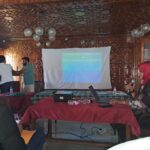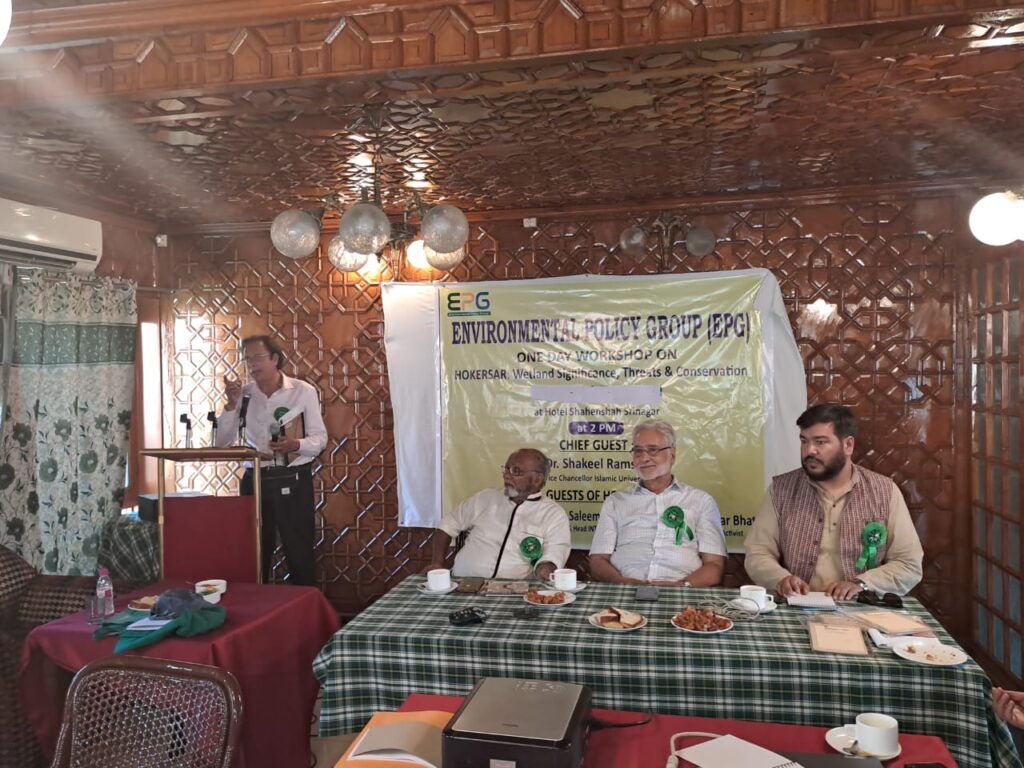All what is serene and natural shall thrive for eternity. The enchanting expanses of UT of J&K aren’t merely about mountains draped in green but also about spaces dotted with waterbodies called wetlands. As listed in the wetlands and water body directory, the UT houses around 565 wetlands/lakes out of which 415 lie in the Kashmir division while the rest 150 are in Jammu. But the richness is at the risk of slipping into the oblivion as anthropogenic chaos, and its manifestations like unplanned urbanisation, pollution poses an existential risk for the water bodies.
Experts, environmentalists and civil society members have time and again deliberated about the possible dawn for the wetlands. J&K Environmental Policy Group(EPG), the first Enviro-Social think tank of J&K founded by cherished environmental lawyer Nadeem Qadri was born out of such deliberations. Recently the group held a comprehensive one day work shop in Srinagar oriented towards deliberations, discussions and awareness on the status of wetlands in the Kashmir region with special focus on Hokersar Wetland, a Ramsar site, also regarded as the ‘Queen of Wetlands in Kashmir‘.
The event witnessed participation from people from all walks of life including academicians, scholars, researchers, EPG advisors, members of Green Citizens Council, lawyers, civil society members, journalists and prominent environmental activists from wetlands of Hokersar, Wular, Heygam and Gurez participated in the workshop.
The interactive part of the wrokshop included showcasing of a comprehensive documentary on the deteriorating condition of Hokersar Wetland by Er. Abdul Rashid, a prominent environmentalist and climate change documentary film maker. Dr. Bazigha Badr, Associate Professor and Head of Department of Environmental Sciences from Amar Singh College Srinagar refelcted on Scientific Perspective of Wetland Issues in Kashmir.
 Dr. Badr said, “Over the last 30 to 40 years the valley is witnessing a climate change with temperatures showing an increasing trend while as the precipitation is decreasing. This year March temperatures set new all-time highest record in J&K. With low precipitation being recorded, the climate change is having a negative impact on the already deteriorating wetlands of Kashmir valley.“
Dr. Badr said, “Over the last 30 to 40 years the valley is witnessing a climate change with temperatures showing an increasing trend while as the precipitation is decreasing. This year March temperatures set new all-time highest record in J&K. With low precipitation being recorded, the climate change is having a negative impact on the already deteriorating wetlands of Kashmir valley.“
One of the speakers Manzoor Ahmad Wangnoo, Chairperson Nigeen Lake Conservation Organization [NLCO] and a renowed environmental activist of the valley credited with the revival of Gil Sar and Khushal Sar lakes in Srinagar, said “There is a dire need to perform at ground level and for this the first step should be the formation of Mohallah committees for carrying out the restoration activities at the local levels. As the local people better understand their surroundings, it can yield better results “.
The planning of development activities in water bodies remained a key concern. Dr. MRD Kundangar, distinguished researcher and environmental expert dwelt on the issue of loss of fauna and flora due to misguided planning pursued in water bodies and wetlands. A team of Wular Lake Activists from Tarzoo, Sopore led by Ajaz Ahmad Dar passionately pleaded the case of the waterbodies of District Baramulla & Bandipore with special reference to Wular and deteriorating status of Hygam Wetland during the workshop.
Hokersar Wetland management issues were specifically addressed in the event. Er. Ajaz Rasool an expert hydraulic engineer and Environmentalist said, “The Hokersar Wetland is being impacted due to certain flood protection projects being carried out by the Flood and Irrigation Department of J&K in its vicinity. It’s our focus that these works are completed as soon as possible so that the required inubdation of the wetland is covered and its previous biotic and aquatic fauna is restored.” He further added that there is a need to update the relevant data and formulate a data bank of all the related statistics for reference of future researchers.
Hokersar Wetland
Hokersar Wetland reserve lies around 10 Kms west of the capital city Srinagar, on Srinagar-Baramulla Highway in the UT of J&K. Oval in shape with an area of 1375 hectares, Hokersar is a natural perennial wetland within the basin of river Jhelum and the only site with remaining reed beds of Kashmir.It is fed by a perennial stream of Dhoodh Ganga that enters into it near Hajibagh village situated on its south-east.
Experts suggest that the havoc caused to Doodh Ganga stream and resultantly Hokersar- the recipient of Doodh Ganga discharge is a major concerning aspect. The loss of Mahaseer fish which enriches the aquatic life of the reseve is another such concern.

Besides being a spawning ground and nursery for fishes, Hokersar wetland is an important pathway for migratory bird species like Large Egret,Great Crested Grebe,Little Cormorant,Common Shelduck,Tufted Duck and endangered White-eyed Pochard,coming from Siberia,China,Central Asia and Northern Europe.
Horkersar Wetland has a century old rich history as it was being used as shooting resort by the then Maharaja Hari singh of J&K state.In 1987, National Wetland Committee of India identified Hokersar as one of the 16 impotant wetlands in the country. Later in 2005, it was designated as a Ramsar site and declared a wetland of international significance.



Once regarded as the “Queen of Wetlands”, Hokersar is now on the brink of extinction due to potential threats like encroachment through landfilling ,garbage littering and demand for increasing tourist facilities.
Dr. Bhat told the Voices, “The condition of Hokersar wetland is worsening day by day due to siltation ,encroachments and disposal of solid waste .I have filed a petition in this regard with the National green Tribunal and the government has agreed to formulate a policy framework with a proper budget allocation for the purpose. As such I am positive and hopeful that we will soon be able to revive the previous glory of Hokersar Wetland.”
A sustained and coordinated intervention was what participants agreed upon. Khurshid Ganai former advisor to Governor and an eminent Green Citizens Council member,acknowledged the efforts of the activists and stressed upon the need for collective and coordinated efforts at various levels by the stakeholders in the restoration of the natural resources of the region.
Image Credits: Syed Tooba
Edited by NK Jha

